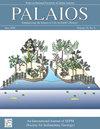侏罗纪--新生代蠕虫洞穴的混合性质,通过微生物对洞壁形成的介导作用来说明
IF 1.5
4区 地球科学
Q2 GEOLOGY
引用次数: 0
摘要
一种新的痕量化石 Macroterebella hoffmanni nov.它是一种管状、分枝状和蜿蜒曲折的洞穴(直径 5-14 毫米),洞壁较厚(0.8-2 毫米),具有微球状纹理。Dobrogea 洞穴的壁中含有大量白云石之后的方解石假象。拉乌洞穴周围有铁锈色晕。洞穴内腔是由追踪者(很可能是小脑虫科的多毛类蠕虫)掘洞而形成的,而洞壁则是非结构性的,其形成是由微生物介导的。Terebellidae产生的粘液内衬洞穴对微生物活动具有吸引力,而微生物活动对金属吸附和矿物成核具有重要的地球化学作用。巨脑虫壁的微球状纹理是细菌介导沉淀的结果,也可能受到胞外聚合物物质(EPS)的影响。一些微生物,特别是产生胞外聚合物质(EPS)的硫酸盐还原菌能够介导白云石的形成,一些微生物细胞可能是白云石的成核点。拉罗乌标本中缺乏白云石,洞穴周围存在铁锈色晕,这可能反映出这些洞穴内的环境地球化学条件与多布罗盖亚标本不同。这项研究证实,碳酸盐环境中洞穴粘膜内的微生物和有机物可能对微量化石的最终外观起着重要的物理化学作用。可以认为,Macroterebella nov. igen.是一种具有生物扰动/生物沉积混合性质的痕量化石。本文章由计算机程序翻译,如有差异,请以英文原文为准。
HYBRID NATURE OF A NEW JURASSIC–CRETACEOUS WORM BURROW INDICATED BY MICROBIAL MEDIATION OF ITS WALL FORMATION
A new trace fossil Macroterebella hoffmanni nov. igen., nov. isp. occurs in Oxfordian and Aptian limestones of Romania, in the Central Dobrogea and the Rarău Mountains, respectively. It is a tubular, branched, and winding burrow (5–14 mm in diameter) displaying a thick wall (0.8–2 mm) with a micropeloidal texture. The Dobrogea burrows contain abundant calcite pseudomorphs after dolomite in the wall. A ferruginous halo occurs around burrows from Rarău. The burrow lumen resulted from burrowing by the tracemaker, most likely a polychaete worm of the family Terebellidae, while the wall is nonconstructional, and its formation was microbially mediated. Terebellids produce mucous-lined burrows, which are attractive for microbial activity which is geochemically important for metal adsorption and mineral nucleation. The micropeloidal texture of the Macroterebella wall is the result of bacterially mediated precipitation and possibly influenced by extracellular polymeric substances (EPS). Some microbes, especially sulphate-reducing bacteria producing extracellular polymeric substances (EPS) are able to mediate the formation of dolomite, and some microbial cells may be nucleation sites for dolomite. The lack of dolomite and the presence of a ferruginous halo around the burrows in the Rarău specimens may reflect different environmental geochemical conditions within these burrows compared with those from Dobrogea. This study confirms that microbes and organic matter in the mucous lining of burrows in a carbonate environment may play an important physicochemical role in the final appearance of trace fossils. Macroterebella nov. igen. can be considered as a trace fossil with a hybrid bioturbation/biosedimentary nature.
求助全文
通过发布文献求助,成功后即可免费获取论文全文。
去求助
来源期刊

Palaios
地学-地质学
CiteScore
2.80
自引率
12.50%
发文量
40
审稿时长
6 months
期刊介绍:
PALAIOS is a monthly journal, founded in 1986, dedicated to emphasizing the impact of life on Earth''s history as recorded in the paleontological and sedimentological records. PALAIOS disseminates information to an international spectrum of geologists and biologists interested in a broad range of topics, including, but not limited to, biogeochemistry, ichnology, paleoclimatology, paleoecology, paleoceanography, sedimentology, stratigraphy, geomicrobiology, paleobiogeochemistry, and astrobiology.
PALAIOS publishes original papers that emphasize using paleontology to answer important geological and biological questions that further our understanding of Earth history. Accordingly, manuscripts whose subject matter and conclusions have broader geologic implications are much more likely to be selected for publication. Given that the purpose of PALAIOS is to generate enthusiasm for paleontology among a broad spectrum of readers, the editors request the following: titles that generate immediate interest; abstracts that emphasize important conclusions; illustrations of professional caliber used in place of words; and lively, yet scholarly, text.
 求助内容:
求助内容: 应助结果提醒方式:
应助结果提醒方式:


